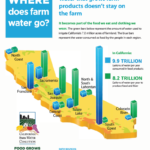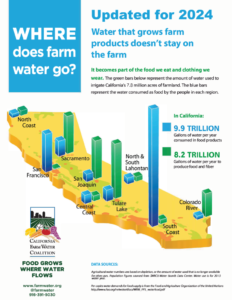Developing Renewable Energy While Protecting the Farms That Grow Our Food
On its web site, The USDA’s National Agricultural Statistics Service (NASS) says it conducts hundreds of surveys every year and prepares reports covering virtually every aspect of U.S. agriculture. The agency reports the facts on American agriculture, “…that are needed by people working in and depending upon U.S. agriculture.”
People that work in agriculture or that depend on agriculture includes pretty much everyone on the planet. Excellent soils and a Mediterranean climate make California one of the most productive agricultural centers in the world, allowing the state to produce two-thirds of the nation’s fruits and nuts, and one-third of its vegetables. Not making the best use of this unique agricultural resource would be a big mistake.
One of the USDA reports says that between 1997 and 2017, in just 20 years’ time, California lost 1 million acres of irrigated farmland. Much of that land was converted to urban or suburban uses and the trend will continue as the state’s population continues to grow.
But population growth isn’t the only threat to California’s position as a world leader in food production. Society’s values have evolved in the last half-century to place a greater importance on priorities other than food production and we can see the results unfolding before our eyes. All too often, we begin to take for granted the basics that become commonplace. COVID-related supply chain disruptions and the war in Ukraine were stark reminders that food security can be fleeting.
A significant challenge facing the state is developing the massive amount of new solar facilities planned over the next two decades while protecting the farmland we depend on as a domestic source of food.
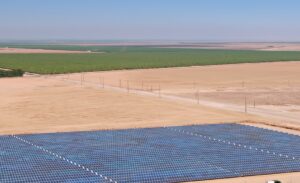
In 2018, the California legislature passed SB 100, the “100 Percent Clean Energy Act of 2018”. SB 100 sets a 2045 target date of supplying all retail electricity sold in California, as well as state agency electricity needs, with renewable and zero-carbon energy resources. This new electricity will come from solar, wind, and geothermal sources. Of the three sources, new solar facilities are expected to account for 81.1 percent of the total. New wind sources are second at 18.8 percent, and new geothermal is a miniscule 0.1 percent.
According to summary of the 2021 SB 100 Joint Agency Report, California will need to add about 70 gigawatts (or 70,000 megawatts) of new commercial solar generation by 2045 to meet the legislative target. The California Energy Commission (CEC) says it requires between seven and 10 acres of solar to generate 1 megawatt of electricity, meaning the state will need 490,000 acres to 700,000 acres of land to generate the 70 gigawatts of solar energy. But does that mean productive farmland will be the only locations for new solar facilities? It doesn’t have to be.
Many tens of thousands of acres of farmland have already been fallowed due to a lack or water or completely retired because of soil quality and drainage concerns. These areas could provide much of the land needed for new solar facilities without being forced to convert producing farms to meet the acreage demand.
A staff report, presented in October to the CEC titled, “Land Use Screens for Electric System Planning,” (3.4 mb PDF) identifies Base Exclusions, or areas where solar cannot be built. Those areas include population centers, military installations, tribal lands, land set aside for environmental protection, mines, and more. When all excluded areas are taken into account, much of the remaining allowable land for solar production is in primarily agricultural areas, including much of the Central Valley, the Salinas, Imperial, and Palo Verde valleys, and some high desert areas from west of Lancaster to Victorville.
 | 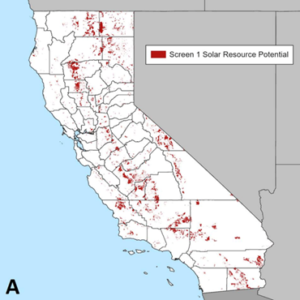 |
| Areas excluded from energy production | Solar resource potential (CEC) |
It is not surprising that there is significant interest in the land potentially fallowed due to the Sustainable Groundwater Management Act (SGMA). In its report, “Solar Energy and Groundwater in the San Joaquin Valley,” the Public Policy Institute of California says that, under SGMA, water users will be required to bring groundwater basins into balance over the next two decades. The report says, “In the San Joaquin Valley, this will likely mean taking more than 500,000 acres of agricultural land out of intensive irrigated production”.
These 500,000 acres that might be retired to meet SGMA goals are in addition to the land that has already gone out of production in the Valley.
It is natural to assume that the CEC would look toward potential farmland conversion as a result of SGMA for sites to locate new energy projects. But it is important to remember that much of the farmland expected to go out of production was at one time sustainably farmed using groundwater resources because adequate surface water supplies helped replenish the aquifer. As a result of periodic droughts, inadequate infrastructure, and water policies that limit surface water deliveries, the declining level of surface water delivered over the last 30 years has contributed directly to current levels of overdraft.
California’s intent should be to build solar facilities on previously retired land and, if additional land is required, to minimize additional retirement and only use land that will be fallowed because of SGMA, as an example. Unless California finds a way to use solar development in some way to support the remaining agricultural land, the question will remain of who will grow the food that feeds the world.
Global population reached 8 billion in November of 2022. At the same time, the 2022 Global Agricultural Productivity (GAP) Report by Virginia Tech College of Agricultural and Life Sciences indicated that global food production is trending 35 percent below the rate needed to meet global food demands in 2050. That means developing countries will face more starvation, and countries like the U.S. will continue to face higher and higher food prices as we compete for more limited supplies in the global market.
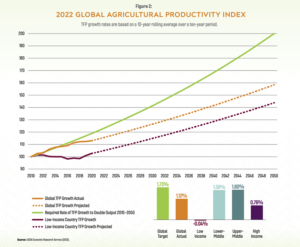 |
| Food production growth, 2022 GAP Report |
The amount of disposable income Americans spend on food has been severely impacted by inflation, which reached a 40-year high with consumer prices up 9.1 percent over the year ended June 2022. The Bureau of Labor Statistics projects that inflation pressures will continue through 2023, increasing the cost of food consumers purchase by an additional 4.5 percent to 10.1 percent on top of price increases they have already experienced. With continued global unrest, such as the war in Ukraine, and needless conversion of fertile agricultural land, it is likely that trends like this will continue.
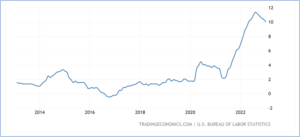 |
| The rate of change in percentage of food price costs. Source: U.S. Bureau of Labor Statistics |
What is the answer? The CEC says it will make every effort to site new solar facilities on the least productive land possible, but solar facilities depend on transmission capabilities to move electricity from where it is generated to where it will be used. Existing transmission lines aren’t currently in all of the areas the CEC identified for potential solar development. That means there is a potential loss of higher value farmland beyond the boundaries of SGMA’s footprint or previously retired farmland where we could see solar facilities taking the place of farms that grow our food. The CEC can work to minimize this by talking to local planners and agricultural advisors, such as county agricultural commissioners and Cooperative Extension specialists. Those experts can provide valuable advice when decisions are being made on where to site new solar facilities.
Throughout California’s history, development has shaped the kind of state in which we live. Developing new sources of renewable energy is a good thing and deserves support. However, we shouldn’t try to fix our energy problem by creating an even bigger food problem.


